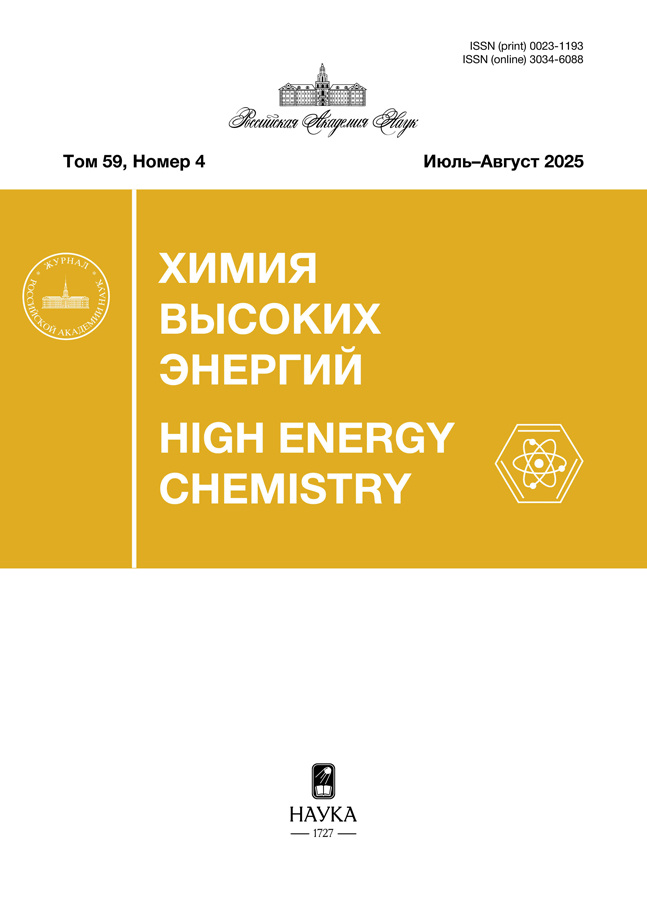Study of radiolysis products of telomeres produced by tetrafluoroethylene polymerization in carbon tetrachloride
- Autores: Shul’ga Y.M.1, Kichigina G.A.1, Kushch P.P.1, Kiryukhin D.P.1
-
Afiliações:
- Federal Research Center for Problems of Chemical Physics and Medicinal Chemistry of the RAS
- Edição: Volume 59, Nº 4 (2025)
- Páginas: 244–248
- Seção: RADIATION CHEMISTRY
- URL: https://consilium.orscience.ru/0023-1193/article/view/687708
- DOI: https://doi.org/10.31857/S0023119325040085
- EDN: https://elibrary.ru/ayehup
- ID: 687708
Citar
Texto integral
Resumo
In this work, tetrafluoroethylene telomers were synthesized in carbon tetrachloride. The resulting telomers were then irradiated in air with 60Co γ-rays at doses in the range of 18–1020 kGy. When studying the IR spectra of the irradiation products, it was found that the intensity of the absorption band (AB) at 850 cm–1, which can be associated with the –CCl3 terminal groups, decreases with increasing irradiation dose. At the same time, a new AB appears in the IR spectrum at ~1775 cm–1, caused by the carboxyl group, the intensity of which increases with increasing irradiation dose. Studying the dependence of the intensity of the noted AB on the dose allowed us to conclude that the removal or transformation of the terminal –CCl3 groups and the formation of –COOH groups are independent processes.
Palavras-chave
Texto integral
Sobre autores
Yu. Shul’ga
Federal Research Center for Problems of Chemical Physics and Medicinal Chemistry of the RAS
Email: kga@icp.ac.ru
Rússia, Chernogolovka
G. Kichigina
Federal Research Center for Problems of Chemical Physics and Medicinal Chemistry of the RAS
Autor responsável pela correspondência
Email: kga@icp.ac.ru
Rússia, Chernogolovka
P. Kushch
Federal Research Center for Problems of Chemical Physics and Medicinal Chemistry of the RAS
Email: kga@icp.ac.ru
Rússia, Chernogolovka
D. Kiryukhin
Federal Research Center for Problems of Chemical Physics and Medicinal Chemistry of the RAS
Email: kga@icp.ac.ru
Rússia, Chernogolovka
Bibliografia
- Кирюхин Д.П., Кичигина Г.А., Кущ П.П., Бузник В.М. // Низкомолекулярные фторполимерные материалы. Монография “Фторполимерные материалы” (Гл. 4). Томск: Изд-во НТЛ, 2017. 600 с.
- Кичигина Г.А., Кущ П.П., Колесникова А.М., Кирюхин Д.П. // Химия высоких энергий. 2011. Т. 45. № 5. С. 431.
- Кирюхин Д.П., Кичигина Г.А., Бузник В.М. // Высокомолек. соед. Серия А. 2013. Т. 55. № 11. С. 1321.
- Fisher W.K., Corelli J.C. //Journal of Polymer Science: Polymer Chemistry Edition.1981. V. 19. № 10. P. 465.
- Liang C.Y., Krimm S.// J. Chem. Phys. 1956. V. 25. № 3. P. 563.
- https://webbook.nist.gov/chemistry/
- Pal D., Agrawal S.K., Chakraborty A., Chakraborty S. // Physical Chemistry Chemical Physics. 2020. V. 22. № 39. P. 22465.
- Kichigina G.A., Kushch P.P., Shulga Y.M., Kabachkov E.N., Kiryukhin D.P. // High Energy Chemistry. 2024. V. 58. № 5. P. 549.
- Hannon M. J., Boerio F. J., Koenig J. L. // Journal of Chemical Physics. 1969. V. 50. № 7. P. 829.
- Yu H., Idesaki A., Hiroki A., Hasegawa S., Hirota K., Maekawa Ya. // Radiat. Phys. Chem. 2024. V. 216. P. 111435.
- Kichigina G.A., Kushch P.P., Kiryukhin D.P. Shulga Y.M. // High Energy Chemistry. 2024. V. 58. № 4. P. 446.
- Lunkwitz K., LappanU., Lehmann D. // Radiat. Phys. Chem. 2000. V. 57. P. 373.
- Hill D. J. T., Thurecht K. J., Whittaker A. K. // Radiation Physics and Chemistry. 2003. V. 67. № 6. P. 729.
- LappanU., GeißlerU., Uhlmann S. // Nuclear Instruments and Methods in Physics Research Section B: Beam Interactions with Materials and Atoms. 2005. V. 236. № 1-4. P. 413.
- Galante A.M.S., Galante O.L., Campos L.L. // Nuclear Instruments and Methods in Physics Research Section A: Accelerators, Spectrometers, Detectors and Associated Equipment. 2010. V. 619. № 1-3. P. 177.
- Lappan U., Geissler U., Lunkwitz K.// Journal of Applied Polymer Science. 1999. V. 74. № 6. P. 571.
- Ennis C.P., KaiserR.I.// Phys. Chem. Chem. Phys. 2010. V. 12. P. 14884.
- Pugmire D.L., Wetteland C.J., Duncan W.S., Lakis R.E., Schwartz D.S. //Polymer Degradation and Stability. 2009. V. 94. № 9. P. 1533.
Arquivos suplementares














